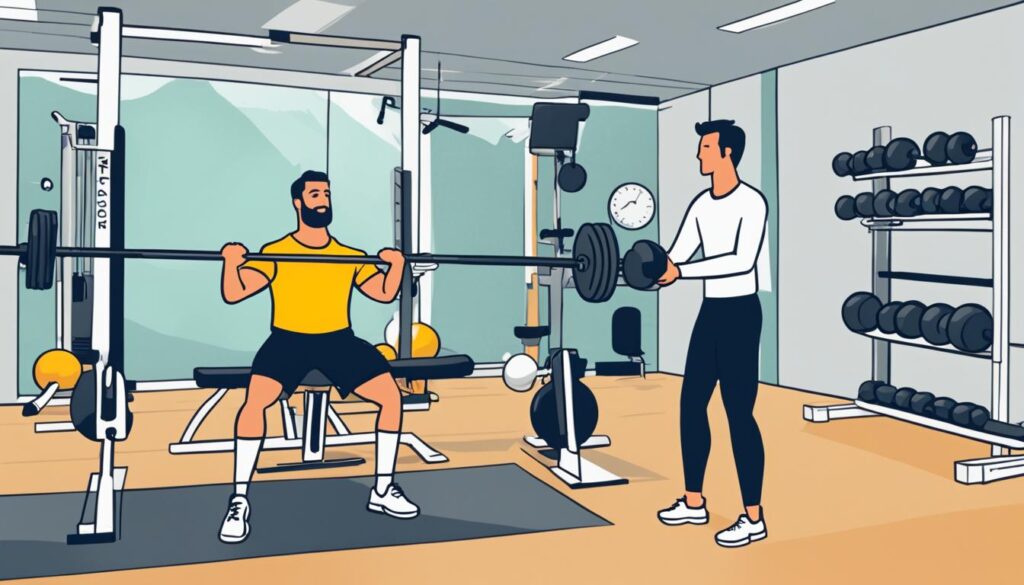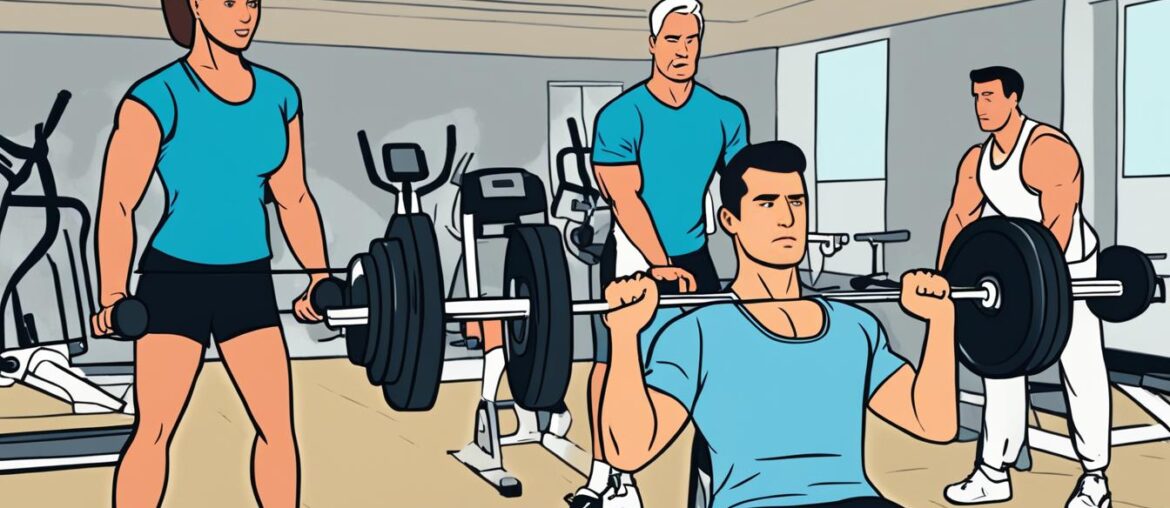Physical therapy can be a transformative approach to weight loss, enhancing mobility and promoting a healthier lifestyle. While physical therapy is not primarily aimed at weight loss, it often leads to weight loss as a secondary effect. The exercises and stretches involved in physical therapy can be strenuous and help burn calories, making it possible to lose weight while receiving treatment. However, physical therapy should be seen as a complement to a healthy lifestyle that includes regular physical activity and nutritious eating.
Key Takeaways:
- Physical therapy can contribute to weight loss as a secondary effect.
- Physical therapy exercises and stretches help burn calories and promote muscle tone.
- Physical therapy should be combined with a healthy lifestyle for long-term weight management.
- Communication with your physical therapist is essential to align weight loss goals.
- Physical therapy improves mobility, reduces pain, and addresses physical limitations, supporting engagement in regular physical activity for weight loss.
The Benefits of Physical Therapy for Weight Loss
Physical therapy offers a wide range of benefits that can aid in weight loss.
One of the key ways physical therapy contributes to weight loss is by improving flexibility. Through targeted stretching and range of motion exercises, physical therapy helps individuals become more limber and mobile, which facilitates overall physical activity.
Physical therapy also focuses on increasing strength and cardiovascular endurance. By incorporating resistance training and aerobic exercises into therapy sessions, individuals can build muscle and improve their overall fitness levels. This, in turn, promotes weight loss by boosting metabolism and calorie burning.
In addition to enhancing physical fitness, physical therapy plays a crucial role in pain reduction. Chronic pain can limit mobility and hinder exercise efforts, making weight loss challenging. Through manual therapies, modalities, and therapeutic exercises, physical therapy can alleviate pain, enabling individuals to engage in more active lifestyles and exercise routines.
Posture and balance issues can also impede physical activity and weight loss progress. Physical therapy addresses these problems by employing specific exercises and techniques that improve posture, stability, and balance. By correcting these issues, individuals can move more efficiently, reduce the risk of falls, and participate in a wider range of exercises, all of which contribute to weight loss.
| Benefits of Physical Therapy for Weight Loss |
|---|
| Improved flexibility |
| Increased strength and cardiovascular endurance |
| Pain reduction |
| Posture and balance improvement |
Overall, physical therapy offers a holistic approach to weight loss by addressing various aspects of physical fitness and well-being. By improving flexibility, increasing strength and cardiovascular endurance, reducing pain, and addressing posture and balance issues, physical therapy supports individuals in their weight loss journey.
Incorporating Physical Therapy into Your Weight Loss Journey

If you are interested in losing weight while undergoing physical therapy, it is essential to communicate your goals with your physical therapist. They can provide guidance, suggestions, and potentially connect you with a trainer and dietician who can assist you further.
It’s important to understand that physical therapy alone is not a cure-all for weight loss; it should be combined with regular physical activity and healthy eating habits. Physical therapy can help restore mobility and function, enabling individuals to engage in more active workouts and exercise routines.
By incorporating physical therapy exercises for weight loss into your routine, you can maximize your chances of success. Your physical therapist can tailor a program that focuses on strengthening and toning exercises, cardiovascular exercises, and flexibility exercises to improve both your physical function and assist in your weight loss journey.
The Role of Physical Therapy in Weight Loss Success
Physical therapy can play a significant role in achieving weight loss success. By working with a physical therapist and following their recommendations, you can:
- Improve your exercise capacity and endurance
- Increase your muscle strength and tone
- Burn calories through targeted exercises
- Improve your overall mobility and range of motion
- Reduce pain and discomfort, enabling you to engage in more physical activity
By incorporating physical therapy into your weight loss journey, you can ensure that you are approaching your goals in a safe and effective manner. Your physical therapist will provide ongoing support and monitor your progress, adjusting your treatment plan as needed.
Incorporating physical therapy into my weight loss journey has been instrumental in my success. Not only am I losing weight, but I also feel stronger and more confident in my physical abilities. The guidance and expertise of my physical therapist have been invaluable in helping me reach my goals.
| Benefits of Incorporating Physical Therapy into Your Weight Loss Journey |
|---|
| Improved overall fitness and mobility |
| Opportunity for personalized exercise programs |
| Guidance from a qualified healthcare professional |
| Reduced risk of injury during exercise |
| Potential for increased weight loss success |
Incorporating physical therapy into your weight loss journey is a smart choice for long-term success. With the right guidance and support, you can achieve your weight loss goals while improving your overall physical fitness and well-being.
The Role of Physical Therapy in Weight Loss
Physical therapy plays a crucial role in weight loss by improving physical function and increasing activity levels. While the primary focus of physical therapy is to restore movement and improve specific body functions, it can contribute to weight loss as a secondary outcome.
Through targeted exercises and techniques, physical therapy helps individuals regain mobility and reduce physical limitations caused by injuries or underlying conditions. By addressing these factors, physical therapy sets the foundation for individuals to engage in regular exercise, promoting weight loss and overall health.
Physical therapists understand the unique challenges individuals may face when trying to lose weight. They work closely with patients to develop personalized treatment plans that focus on restoring mobility and functionality, which in turn support weight loss efforts. By incorporating physical therapy into a weight management program, individuals can overcome physical barriers and achieve their weight loss goals.
Moreover, physical therapy helps individuals build strength, improve cardiovascular endurance, and enhance flexibility, all of which are crucial for sustainable weight loss. By empowering individuals to move more efficiently, physical therapy enables them to engage in regular physical activity and burn calories effectively.
Ultimately, physical therapy serves as an important component of a comprehensive approach to weight management. By addressing physical limitations and improving overall physical function, physical therapy equips individuals with the tools they need to lead a healthier and more active lifestyle, thereby facilitating long-term weight loss and promoting overall well-being.
Physical Therapy Techniques for Weight Loss
When it comes to weight loss, physical therapists employ a variety of techniques and exercises to promote successful outcomes. These techniques are tailored to each individual’s condition and goals, ensuring a personalized program that supports weight loss efforts.
One of the key components of physical therapy for weight loss is strength training exercises. These exercises help build and tone muscles, which contributes to increased calorie burning and improved overall physical fitness. By incorporating resistance training into therapy sessions, physical therapists assist individuals in achieving their weight loss goals.
In addition to strength training, cardiovascular exercises play a vital role in a physical therapy program for weight loss. Engaging in activities that elevate the heart rate, such as brisk walking or cycling, helps burn calories and improve cardiovascular endurance. Physical therapists guide patients through these exercises, ensuring safe and effective workouts that maximize weight loss potential (check out my post on maximize weight loss here).
Balance and stability exercises are also essential in a physical therapy regimen for weight loss. These exercises help individuals improve their coordination, stability, and posture, making it easier to engage in more challenging workouts. By enhancing balance and stability, physical therapists empower patients to incorporate a wide range of physical activities into their weight loss journey.
Flexibility exercises are another crucial component of physical therapy for weight loss. These exercises help improve range of motion, alleviate muscle tightness, and prevent injuries during physical activity. By increasing flexibility, physical therapists enable individuals to perform a wider variety of exercises, leading to more effective weight loss outcomes.
“Physical therapy techniques for weight loss encompass strength training exercises, cardiovascular exercises, balance and stability exercises, and flexibility exercises.”
Examples of Physical Therapy Techniques for Weight Loss
| Technique | Description |
|---|---|
| Strength Training | Resistance exercises to build muscle and increase calorie burning |
| Cardiovascular Exercise | Activities that elevate heart rate and improve endurance |
| Balance and Stability Training | Exercises to enhance coordination and stability for more challenging workouts |
| Flexibility Exercises | Stretching routines to improve range of motion and prevent injuries |
Using a combination of these techniques, physical therapists work with individuals to develop a comprehensive and personalized weight loss program. Through targeted exercises, they promote calorie burning, muscle toning, and overall physical fitness, enabling individuals to achieve their weight loss goals successfully.
How Physical Therapy Supports Weight Loss Goals

Physical therapy plays a crucial role in supporting weight loss goals by addressing physical limitations, reducing pain, and improving overall physical function. By alleviating pain and increasing mobility, individuals can engage in more active and sustained exercise routines, leading to greater calorie burning and weight loss.
One of the key ways that physical therapy supports weight loss is by focusing on decreasing pain. Chronic pain can hinder movement and make it challenging to engage in physical activity. Through targeted therapies, such as manual therapy and therapeutic exercises, physical therapists help individuals manage pain and improve their ability to exercise.
Additionally, physical therapy enhances overall physical function, which contributes to weight loss success. Therapists work with individuals to improve strength, flexibility, balance, and posture. By addressing these areas, physical therapy optimizes the body’s ability to perform exercises and movements effectively.
Proper body mechanics, posture, and movement are essential for efficient and safe exercise. Physical therapy educates individuals on these aspects, empowering them to perform exercises correctly and prevent injuries. By learning how to move and exercise in a way that supports their body’s function, individuals can maximize the effectiveness of their workouts and minimize the risk of setbacks or pain.
Incorporating physical therapy into a weight loss program provides personalized guidance and support tailored to an individual’s specific needs. Physical therapists assess each person’s condition, identify areas of improvement, and develop a comprehensive treatment plan that includes exercises and techniques to promote weight loss and overall wellness.
Benefits of Physical Therapy for Weight Loss:
- Reduced pain and improved mobility
- Enhanced strength, flexibility, and balance
- Proper body mechanics and posture
- Personalized guidance and support
To illustrate the impact of physical therapy on weight loss goals, consider the following example:
John, a 45-year-old individual struggling with weight management due to chronic knee pain, decided to incorporate physical therapy into his weight loss journey. Through a combination of manual therapy, targeted exercises focusing on strengthening and stretching the surrounding muscles, and education on proper body mechanics, John experienced reduced pain and increased mobility. With the support of his physical therapist, he was able to engage in regular exercise that included cardio workouts, strength training, and flexibility exercises. Over time, John’s weight loss success was evident, and he reported improved overall physical function and a newfound confidence in pursuing an active and healthy lifestyle.
To summarize, physical therapy supports weight loss goals by addressing physical limitations, reducing pain, and improving overall physical function. By decreasing pain and increasing mobility, individuals can engage in more active and sustained exercise routines, leading to greater calorie burning and weight loss. Physical therapy also educates individuals on proper body mechanics and movement, enhancing the effectiveness of exercise and promoting long-term weight management.
The Impact of Physical Therapy on Weight Loss and Well-being
Physical therapy can have a significant impact on weight loss and overall well-being. In addition to aiding in weight management, physical therapy helps individuals improve their quality of life by increasing flexibility, strength, and cardiovascular endurance. It can also help prevent age-related conditions such as arthritis and osteoporosis. Furthermore, physical activity has been linked to improved mental health, reducing the risk of conditions like depression. By promoting physical fitness and supporting weight loss efforts, physical therapy contributes to a healthier and happier lifestyle.
Through a combination of therapeutic exercises, stretches, and techniques tailored to individual needs, physical therapy supports weight loss goals by:
- Increasing flexibility: Improved flexibility allows for a wider range of motion during exercise, enabling individuals to perform more varied and challenging workouts for enhanced weight loss results.
- Building strength: Strengthening exercises in physical therapy sessions help develop muscle mass, which increases the body’s metabolism, leading to more efficient calorie burning even at rest.
- Enhancing cardiovascular endurance: Physical therapy includes cardiovascular exercises that improve heart health and endurance, enabling individuals to engage in longer and more intense workouts for optimal weight loss benefits.
By addressing physical limitations and reducing pain, physical therapy also supports weight loss efforts by:
- Decreasing pain: Pain-free movement promotes engagement in regular physical activity, allowing individuals to perform exercises that contribute to weight loss without discomfort or limitations.
- Improving overall physical function: Physical therapy addresses underlying issues that may contribute to weight gain, such as poor posture or imbalanced movement patterns, helping individuals adopt healthier movement habits that support weight loss and overall well-being.
Incorporating physical therapy into a weight loss journey provides guidance, support, and professional expertise to ensure safe and effective progress. Physical therapists work closely with individuals to create personalized exercise programs that align with their goals and abilities, maximizing the benefits of physical therapy for weight loss.
Physical therapy not only contributes to weight loss but also plays a vital role in improving overall well-being. By alleviating pain, increasing mobility, and empowering individuals to engage in regular exercise, physical therapy sets the foundation for long-term weight management and a healthier, more fulfilling life.
Physical Therapy for Long-term Weight Management

Physical therapy is not only an effective tool for initial weight loss but also for long-term weight management. By addressing the underlying issues that contribute to weight gain and improving physical function, physical therapy equips individuals with the knowledge and skills necessary to maintain a healthy weight in the long run.
During physical therapy sessions, individuals learn techniques and exercises that promote weight loss, such as strength training, cardiovascular exercises, and flexibility exercises. These activities not only burn calories but also improve muscle tone and overall physical fitness.
In addition to the physical aspects, physical therapists provide ongoing support and guidance to help individuals sustain their weight loss efforts. They can offer strategies for incorporating physical activity into daily routines, advise on proper nutrition, and monitor progress to ensure long-term success.
By combining the benefits of physical therapy with a healthy lifestyle that includes regular exercise and proper nutrition, individuals can achieve and maintain their weight loss goals. Furthermore, physical therapy helps individuals address and overcome any physical limitations or barriers they may face on their weight loss journey.
Whether recovering from an injury or managing a chronic condition, physical therapy plays a crucial role in helping individuals lead an active and fulfilling life while maintaining a healthy weight. The individualized approach of physical therapy ensures that each person receives the support and guidance they need to achieve long-term weight management and overall wellness.
With physical therapy, losing weight and keeping it off becomes a sustainable and achievable goal.
By improving physical function, addressing underlying issues, and providing ongoing support, physical therapy sets individuals on the path to long-term weight management and a healthier lifestyle.
Can Behavioral Therapy be Combined with Physical Therapy for Weight Loss?
Yes, behavioral therapy can be combined with physical therapy to achieve effective weight control therapy. By addressing both the psychological and physical aspects of weight loss, individuals can adopt healthier habits and increase their activity levels, leading to successful and sustainable weight management.
Conclusion
In conclusion, physical therapy is a valuable tool in achieving weight loss goals. While it may not be the primary focus of physical therapy, the exercises and techniques used in therapy sessions contribute to calorie burning, muscle development, and overall fitness. By improving mobility, reducing pain, and addressing physical limitations, physical therapy supports individuals in engaging in regular physical activity that promotes weight loss.
To maximize the benefits of physical therapy for weight loss, it is crucial to combine it with a healthy lifestyle that includes nutritious eating and consistent exercise. Physical therapy serves as a foundation for individuals to lead an active lifestyle and manage their weight in the long term. Through physical therapy, individuals can develop the knowledge, skills, and strategies necessary to maintain a healthy weight and overall well-being.
If you are considering physical therapy for weight loss, consult with a physical therapist who can design a personalized program tailored to your needs. Remember that physical therapy is not a stand-alone solution for weight loss, but rather a complementary approach that enhances the effects of a healthy lifestyle. By integrating physical therapy into your weight loss journey, you can achieve sustainable results and enjoy the numerous benefits it provides for your overall health and well-being.
FAQ
How can physical therapy help you lose weight?
Physical therapy can aid in weight loss by improving flexibility, increasing strength and cardiovascular endurance, reducing pain, and addressing posture and balance issues. The exercises and stretches involved in physical therapy sessions can help burn calories and improve muscle tone, contributing to weight loss.
What are the benefits of physical therapy for weight loss?
Physical therapy not only supports weight loss but also enhances overall well-being. It improves physical function, increases flexibility, strength, and cardiovascular endurance. Additionally, physical therapy can prevent age-related conditions such as arthritis and osteoporosis and has been linked to improved mental health.
How can you incorporate physical therapy into your weight loss journey?
To incorporate physical therapy into your weight loss journey, communicate your goals with your physical therapist. They can provide guidance, suggestions, and potentially connect you with a trainer and dietician. Remember to combine physical therapy with a healthy lifestyle that includes regular physical activity and nutritious eating habits.
What is the role of physical therapy in weight loss?
The primary focus of physical therapy is to restore movement and improve specific body functions. However, physical therapy also contributes to weight loss as a secondary outcome. By improving physical function, reducing pain, and addressing underlying issues, physical therapy sets the foundation for individuals to engage in regular exercise and promote weight loss.
What are some physical therapy techniques for weight loss?
Physical therapy techniques for weight loss may include strength training exercises, cardiovascular exercises, balance and stability exercises, and flexibility exercises. These techniques promote calorie burning, muscle toning, and overall physical fitness, aiding in weight loss.
How does physical therapy support weight loss goals?
Physical therapy supports weight loss goals by improving physical function, reducing pain, and increasing mobility. By decreasing pain and increasing mobility, individuals can engage in more active and sustained exercise routines, leading to greater calorie burning and weight loss. Physical therapy also educates individuals on proper body mechanics, posture, and movement, enhancing the effectiveness of exercise and promoting long-term weight management.
What is the impact of physical therapy on weight loss and well-being?
Physical therapy can have a significant impact on weight loss and overall well-being. It aids in weight management, enhances flexibility, strength, and cardiovascular endurance, and prevents age-related conditions such as arthritis and osteoporosis. Physical activity also improves mental health, reducing the risk of conditions like depression.
Is physical therapy useful for long-term weight management?
Yes, physical therapy is not only useful for initial weight loss but also for long-term weight management. By improving physical function and addressing underlying issues contributing to weight gain, physical therapy equips individuals with the knowledge and skills to maintain a healthy weight in the long run. Physical therapists can provide ongoing support, guidance, and strategies to help individuals sustain their weight loss efforts and develop a sustainable lifestyle.
How effective is physical therapy for weight loss?
Physical therapy can be a valuable tool in achieving weight loss goals. While it may not be the primary focus of physical therapy, the exercises and techniques used in therapy sessions contribute to calorie burning, muscle development, and overall fitness. However, it’s important to combine physical therapy with a healthy lifestyle that includes nutritious eating and consistent exercise for long-term weight management and overall well-being.
Source Links
- https://www.orthonowcare.com/2021/02/04/losing-weight-while-in-physical-therapy-is-it-possible/
- https://www.orthorehabpt.com/physical-therapy-lose-weight/
- https://intecore-pt.com/can-physical-therapy-help-me-lose-weight/




